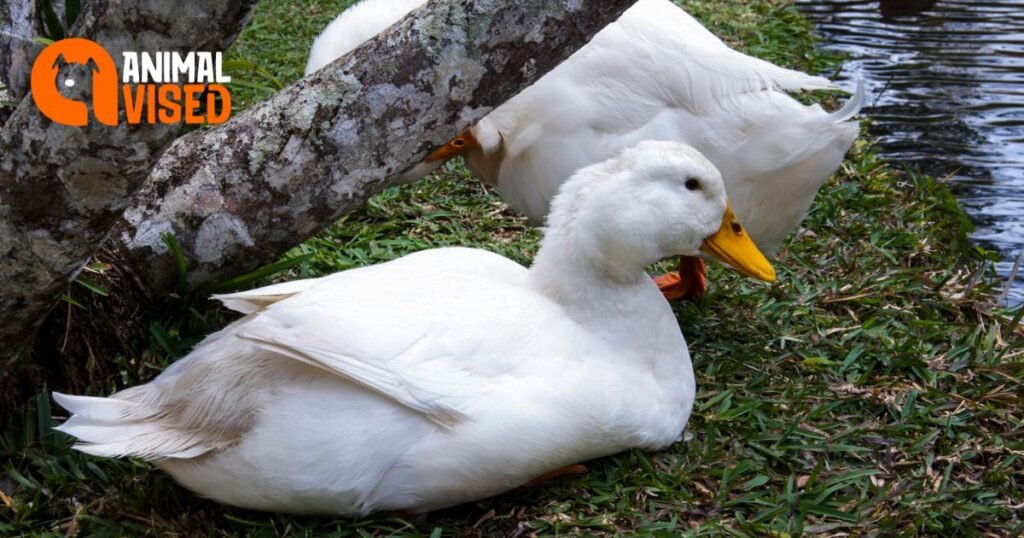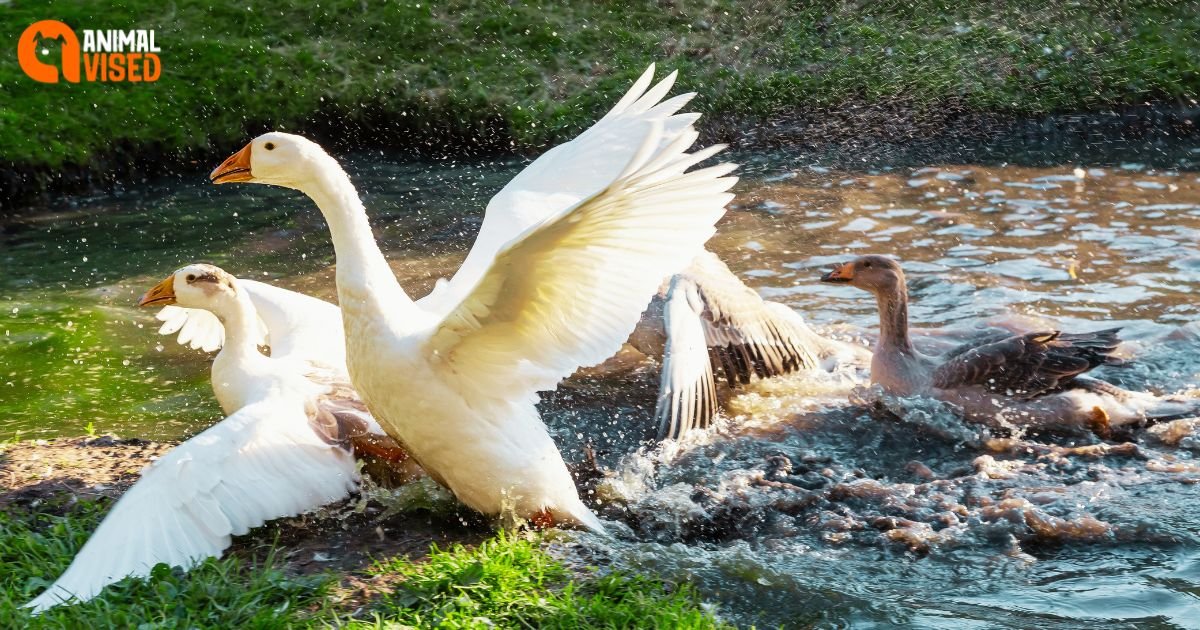Introduction
If you’re looking to add a productive egg layer to your backyard flock, look no further than the cheerful Pekin duck! At Animal Vised, we’re diving into everything you need to know about Pekin duck eggs – from their exceptional taste and unique coloring to tips on collecting, incubating, and even selling fertile eggs. Read on as we cover common questions, typical production levels across Pekin duck lifespans, and how to configure housing setups encouraging these domestic ducks to feel safe laying to their little heart’s content!
Pekin Duck Breed Overview
Let’s begin by getting to know the origins of the Pekin breed and their key characteristics that lend well to prolific egg production:
History
- Native to China before introduction to America and Europe in the 1870s
- Quickly adopted into Western poultry markets for meat and eggs
- Remain the most popular duck breed today
Traits
- Large white feathered bodies with yellow beaks/feet
- Docile temperament perfect for backyard flocks
- Hardy constitution tolerating variable climates
- Excellent egg production rates
If you’re seeking a duck breed adept at laying plentiful white-shelled eggs across seasons – the easygoing Pekin is surely set to deliver without too many demands!
Read More: Duck Ears

Pekin Duck Egg Production
So what exactly can you expect once your Pekin ducks reach peak laying age? Let’s crunch the numbers:
When They Start Laying
- Sexual maturity from 5-6 months old
- Egg production commences from spring onwards
- The most prolific period falls between the second and fourth years
Annual Egg Production
- Typical annual output between 150-300 eggs per healthy duck
- The highest documented rates exceed 350 eggs by exceptional individuals!
- Better than chickens at peak production born same hatch year!
Laying Lifespan
- Steady laying capacity between 2-5 years of age
- Gradually decline nearing the eighth year
- Exceptional ducks may continue into double-digit age but fertility also decreases
Investing in a small flock of young Pekin Duck Eggs with staggered ages supports sustained egg abundance to keep you replete with this palette-pleasing poultry product!
Pekin Duck Egg Attributes
What makes Pekin duck eggs stand out beyond volume alone? Let’s highlight special qualities distinguishing them from common chicken eggs:
Color
- Chalky white shells – no brown dappled pigmentation
- Opaque appearance differs from translucent chicken eggs
- Rare blue or green shell genes are possible but not commercially utilized
Size & Shape
- Large egg size – average 2.5-3oz each!
- Oblong oval shape with a more sharply tapering end
Frequency
- Less often than daily chicken lay rates
- Usually every 1.5-2 days per duck
- Allow access to plenty of nest boxes to prevent egg pileups!
Nutritional Advantages
- Higher omega fatty acids like Omega-3
- More folate, vitamin B12, minerals like iron
- Rich taste described as creamy and eggy-er!
Adding duck eggs into your culinary repertoire yields exciting flavor and nutrition benefiting any menu!
Configuring Housing Setup
To fully capitalize on prolific Pekin production capacity, strategic housing configurations using these pointers can exponentially boost success:
Enclosed Shelter
- Protect flock from predators, rain, and wind
- Allow 8 square feet of interior space per Pekin duck
- Deep bedding litter for nesting comfort
Fenced Outdoor Run
- Opens more living space when weather permits
- Rotate pens to give pastures recovery periods
- Provides vegetation foraging opportunities
Swimming Access
- Small wading pool or pond enclosure if possible
- Ducks adore swimming and will up egg laying if able!
- Allows instinctive preening behaviors keeping feathers healthy
Proper Lighting
- Ensure a minimum of 14 hours daily artificial light
- Triggers hormonal cues to keep eggs flowing
- Position lights to avoid overheating enclosed shelters
Follow this guidance for housing that hummingly keeps the eggs coming from your QUACKerjack Pekin duck team!
Egg Collection & Storage
To harvest maximum Pekin Duck Eggs yield while maintaining safety and freshness, utilize these handy collection and storage strategies:
Frequent Gathering
- Collect eggs multiple times daily
- Removing eggs prompts more frequent laying cycles
- Prevent eggs from piling up if unable to gather daily
Nest Box Setup
- Provide individual enclosed nest compartments
- Entrances allowing ducks but preventing chickens
- Deep bedding is changed weekly when soiled
Cleaning & Storing
- Gently wash if visibly soiled using non-scented soap
- Let dry fully before storage in the fridge
- Place large end up to keep air cell stable
- Maintain cool temps consistently under 55°F
Follow this diligent duck egg gathering routine to cleanly harvest prime poultry production!
Common Issues
While Pekin ducks typically thrive when basic welfare standards are met, be alert to a few potential issues disrupting laying productivity:
Stressors Causing Egg Eating
Too few nest boxes, overcrowding, loud noises, or habitat disturbances can stress ducks, triggering abnormal behaviors like egg eating. Pekin Duck Eggs Boost enrichment and evaluate root cause if egg loss is reported.

Broodiness & No Egg Production
Some Pekin hens may stop laying to enter extended broody phases while attempting to hatch eggs. Pekin Duck Eggs Gently disrupt urges through isolation if sustained productivity is desired over duckling numbers.
Day Length Confusion
Egg production can take unexpected dips if light/darkness exposure gets disrupted, like during power outages or transition periods between seasons. Maintain 14-hour+ artificial light minimums to stay on the biological track.
Molting & Temporary Decline
Annual feather molting phases normally last 1-2 months. Egg production understandably dips during this taxing regeneration period as the duck’s energy focuses on replenishing plumage quality.
Stay alert to subtle signals from Pekins signaling any impediments thwarting their egg-laying prowess so tweaks can be made to restore their feathered contentment!
Breeding Pekin Ducks
If raising baby ducklings sounds more enchanting than grocery egg gathering, review these tips before introducing Mr. and Mrs. Mallards to commence courting:
Ideal Breeding Age
- Sexual maturity reached at 5-8 months old
- Peak fertility levels around the second spring season
Breeding Ratios
- 10-12 duck hens per drake is optimal
- More hens mean limited competition
- Let females choose mate preference
Safe Introduction
- House drakes separate before gradual intros
- Watch closely for signs of aggression
- Remove bullies impeding hen comfort
Once harmonious pairs form, expect cute little carbon copies to start fluffing up your duck coop come springtime!
Hatching Fertile Duck Eggs
If you don’t wish to keep a resident drake but still want to hatch adorable ducklings, collecting Pekin duck eggs for sale from local breeders allows for family expansion without the commitment of a permanent boys club!
Incubation Timeline
- 28-day incubation period
- 99°F and 60% humidity crucial
- Requires stillness so hatch rates are higher with incubators over broody hens
Developmental Changes
- Air cell and blood vessels visible from Day 5
- Embryo attachment and first sounds emerge around Day 10
- Feathers and steady growth from Day 21+ signal readiness to pip the shell
Hatch Preparation
- Stop turning eggs 3 days pre-hatch
- Raise humidity for ease exiting the shell
- Resist helping to allow full muscle development
Welcome your ducklings to the world once fully dry and fluffy – then prepare for utter cuteness overload from these fuzzy balls of fun waddling behind their broody mothers!
Enjoying & Preserving Eggs
Once gathered, how best to enjoy your duck egg bounties? We have savory ideas for all seasons:
Cooking Duck Eggs
- Bake fluffy soufflés and quiches showcasing rich flavor
- Prepare brunch classics like duck egg omelets or Eggs Benedict
- Explore using in breads, pancakes, homemade pasta, or pickled
- Sauté savory duck egg stir fries with veggies
Preserving Surplus
- Pickle excess eggs to use later for pub snacks or charcuterie
- Dehydrate into powder for nutritional boosts to smoothies, broths & baked goods
- Freeze diced egg pieces measured for convenient addition into dishes later
However, your duck egg cuisine creativity cracks open – their impressive versatility guarantees these gifts from assiduous Pekin layers delight palettes all year long!
Selling Pekin Duck Eggs
With prolific production whipping up more eggs than your family can handle, consider supplementing feed costs by selling surplus duck eggs!
Confirm Local Cottage Laws
- Research specific municipality codes for allowable home egg sales
- Obtain any needed permits, licenses, or insurance
Spread The Word
- Create eye-catching duck egg posters to advertise availability
- Promote at farmer’s markets, farm stands, and rural feed stores
- Offer bulk pricing for resellers like local restaurants
Packaging & Labeling
- Purchase egg cartons and packaging meet commercial standards
- Properly label with farm name/description plus safe handling instructions
Soon friends, neighbors, and foodies flock faithfully for the freshest fertile fowl eggs in town thanks to your endearing Pekins!
All About Pekin Duck Eggs From Farm Fresh to Hatching at Home
Welcome to Animal Vised, your one-stop shop for exploring the fascinating world of animals! Today, we delve into the world of Pekin ducks, a popular breed known for their egg-laying abilities. Pekin Duck Eggs Whether you’re curious about Pekin duck egg color, hatching them at home, or simply where to find them, this article is your guide.
Unveiling the Pekin Duck A Feathered Egg-cellent Performer
Pekin ducks, also known as White Pekin ducks, are a domesticated breed originating from China. They are known for their calm temperament, white plumage, and impressive egg-laying capabilities. These ducks are widely raised for their meat and eggs, making them a staple in many cultures.
A Look Inside The Characteristics of Pekin Duck Eggs
Pekin duck eggs are generally larger than chicken eggs, boasting a distinctive white or slightly creamy color. They possess a richer flavor and higher fat content compared to chicken eggs, making them ideal for baking and specific culinary applications.
The Lifecycle of Laying When and How Often Do Pekin Ducks Lay Eggs
Pekin ducks typically begin laying eggs around 20 weeks of age, although this can vary depending on several factors like breed, environment, and individual health. They are considered prolific egg layers, laying between 4-5 eggs per week at their peak. This production may slow down as they age, but they can continue laying eggs for several years.
Hatching Pekin Duck Eggs at Home Exploring the Possibilities
For some, the allure lies not just in consuming Pekin duck eggs but also in hatching and raising ducklings. Pekin Duck Eggs If you’re considering hatching Pekin duck eggs at home, it’s crucial to research extensively and ensure you can provide proper care for the hatchlings.
Here are some key considerations:
- Acquiring fertile eggs: Look for reputable sources that sell fertile Pekin duck eggs specifically for incubation.
- Incubation setup: You’ll need an incubator that can maintain the proper temperature and humidity levels for successful hatching.
- Hatchling care: Ducklings require specific care, including a warm and clean brooder, proper nutrition, and access to water.
Where to Find Pekin Duck Eggs Exploring Your Options
Finding Pekin duck eggs may not be as straightforward as finding chicken eggs at your local grocery store. Here are some potential avenues to explore:
- Local farms: Look for farms specializing in raising ducks for meat or eggs. They might sell Pekin duck eggs directly or connect you with other breeders.
- Online retailers: Several online retailers offer Pekin duck eggs for sale. However, ensure they have a good reputation and prioritize responsible breeding practices.
- Hatcheries: Some hatcheries might sell Pekin duck eggs for breeding purposes.
Before purchasing Pekin duck eggs, inquire about the seller’s practices, egg quality, and any potential health certifications.
Conclusion
We hope you’re now fully prepared to capitalize on the impressive egg output possible when raising flocks of unflappable Pekin ducks! From housing considerations to harvesting tips plus recipe ideas both savory and sweet – our comprehensive guide covered key concepts to cue phenomenal production. Pekin Duck Eggs When cared for thoughtfully, these cheerful ducks handsomely reward diligent owners with gorgeous Grade A protein-packed oval offerings. Remember to check back as the Animal Vised team continues cracking open more animal husbandry topics near and farmyard!

Read More: Pekin Duck Eggs
FAQs
What is Animal Vised?
Animal Vised is a website dedicated to exploring the fascinating world of animals! We provide informative and engaging content about various animal species, their behaviors, habitats, and conservation efforts.
What kind of content can I find on Animal Vised?
You can find a variety of content on Animal Vised, including:
- Animal profiles: We delve into the lives of different animal species, exploring their unique characteristics, habitats, and behaviors.
- Conservation spotlights: We highlight important conservation efforts and organizations working to protect endangered species and their ecosystems.
- Animal care guides: We provide basic information and resources for responsible animal ownership, including pet care tips and information about specific breeds.
- Fun facts and trivia: We share interesting and engaging details about the animal kingdom to spark curiosity and appreciation.
Can I trust the information on Animal Vised?
We strive to provide accurate and up-to-date information based on credible sources, including scientific studies, reputable organizations, and expert opinions. However, we encourage further exploration and research using the provided resources for any specific needs.
Who writes the content on Animal Vised?
Our content is created by a team of passionate animal enthusiasts and experienced writers. We combine our knowledge and research skills to deliver informative and engaging content for our readers.
Can I contribute to Animal Vised?
While we don’t currently accept guest posts, we appreciate your interest! We encourage you to share your feedback and suggestions through our contact form.
Where can I find more information about a specific animal or topic?
We often include links to relevant sources and organizations within our articles. Additionally, you can use the search bar on our website to explore specific topics or animal species.
Do you offer any educational resources for children?
While our content is generally suitable for all ages, we are currently working on developing a dedicated section with age-appropriate content and resources for children to learn about animals in a fun and informative way.
How can I stay updated with new content from Animal Vised?
You can subscribe to our newsletter using the form on our website to receive updates about new articles and content. You can also follow us on social media for additional updates and engaging animal content.










